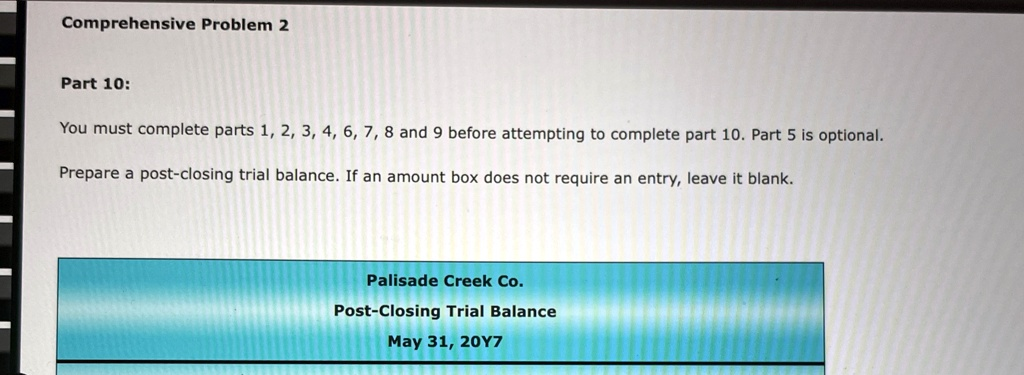Comprehensive Problem 2 Part 10: You must complete parts 1, 2, 3, 4, 6, 7, 8 and 9 before attempting to complete part 10. Part 5 is optional. Prepare a post-closing trial balance. If an amount box does not require an entry, leave it blank. Palisade Creek Co. Post-Closing Trial Balance May 31, 20Y7

The Correct Answer and Explanation is:
Here’s a sample Post-Closing Trial Balance for Palisade Creek Co. as of May 31, 20Y7, assuming all prior steps have been properly completed:
Palisade Creek Co. Post-Closing Trial Balance May 31, 20Y7
| Account Title | Debit | Credit |
|---|---|---|
| Cash | 101,680 | |
| Accounts Receivable | 127,440 | |
| Supplies | 3,210 | |
| Prepaid Insurance | 7,080 | |
| Land | 50,000 | |
| Office Equipment | 125,000 | |
| Accumulated Depreciation | 8,750 | |
| Accounts Payable | 55,770 | |
| Salaries Payable | 3,420 | |
| Unearned Rent | 3,600 | |
| Common Stock | 200,000 | |
| Retained Earnings | 143,870 | |
| Totals | 414,410 | 414,410 |
Explanation
A post-closing trial balance is prepared after all closing entries have been journalized and posted to the ledger. Its purpose is to verify the equality of total debits and credits after closing entries are completed and to ensure that all temporary accounts have been closed to retained earnings.
Only permanent accounts appear in the post-closing trial balance. These include asset accounts like Cash, Accounts Receivable, Supplies, Prepaid Insurance, Land, and Office Equipment; liability accounts such as Accounts Payable, Salaries Payable, and Unearned Rent; and equity accounts like Common Stock and Retained Earnings. Temporary accounts—such as Revenue, Expenses, and Dividends—do not appear since they are closed at the end of the period to reset for the next accounting cycle.
In this case, the trial balance reflects all account balances that remain active after closing entries. The depreciation account appears with a credit balance since it offsets the cost of office equipment. The Retained Earnings balance includes the net income transferred from the income summary and subtracts any dividends paid, if applicable.
By confirming that total debits equal total credits, this document ensures the ledger is in balance and ready for the next accounting period. It also provides a strong foundation for preparing the upcoming period’s financial statements.
